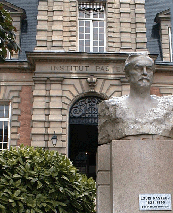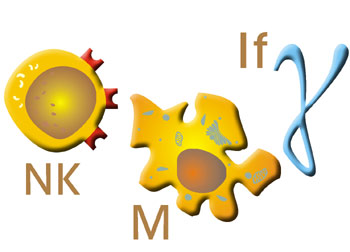| Chapter 1. What is immunology? | | | | | | Immunology is the field of science that studies the mechanisms by which animals can discern between their own components and foreign ones, react against the foreign components and memorize them for the future. | | | 
Fig 1. Pasteur Institute (Paris) | Immunology was first studied as a scientific subject in the 18th century as part of the field of microbiology. The first vaccine against smallpox appeared at this time. Edward Jenner (1749-1823) observed that people who had suffered from bovine smallpox were resistant to the human strain. These studies continued until the 19th century, when thanks to the work of Louis Pasteur (1822-1895), new technologies were developed which made possible the creation of vaccines against several human and animal diseases. One of the first concepts defined in the development of immunology was the term immune. This refers to those persons or animals who were resistant to an infection, having survived it or not having suffered from it. The following two concepts appeared: natural immunity and adaptive immunity. | |  Fig 2. Natural immunity is the first non-specific immunological barrier. The first mediators of this natural immunity are the phagocytic cells (M), natural killer cells (NK) and interferon (If).
|
As well as the physical barriers (skin, mucous secretions, acidic pH in the stomach, proteolytic enzymes, etc), which are very important in fighting antigens, mammals have other non-specific mechanisms which give them natural immunity. Natural immunity is the first non-specific immunological barrier of the pig for fighting infections against which it has not been previously immunized. This response takes place within a few minutes or hours of suffering an aggression and is principally mediated by phagocytic cells, NK cells and interferon. When this first barrier fails, infection is established and adaptive immunity starts to develop. The immunological mechanisms related to natural immunity are linked to non-specific mechanisms; i.e. they are not produced by the presence of a specific antigen. | | 
Fig 3. Adaptive immunity comes about as a response to a specific antigen, after collaboration amongst phagocytic cells (M), T and B lymphocytes and the production of inmunoglobulins (Ac) and cytokines.
| Adaptive immunity is the result of the immune response against a molecule or agent which is foreign to the animal (antigen). A specific response is generated against an external stimulus. After the capturing process and recognition of the antigens, mechanisms of presentation and activation of the lymphocytes are triggered in order to produce antibodies and cytokines. From the first concepts up to the present day, our knowledge of immunology has advanced progressively. The most important advances in immunology in general and porcine immunology in particular have been made over the last few decades. There have been three major developments which have improved our knowledge of the different immune system mechanisms in pigs: | | 1.- The development of syngeneic pigs for the swine histocompatibility system (SLA). | | 2.- Monoclonal antibodies. | | 3.- Advances in techniques of molecular biology. | | Three histocompatibility antigens have been identified in pigs. They are known as: | Syngeneic pigs for the porcine histocompatibility system (SLA) have allowed more knowledge to be gained of the genetic control of the porcine immune response and its relationship to different pathogens. Monoclonal antibodies have allowed highly specific reagents to be used against the different cells of the porcine immune system and better understanding of their role in immune response mechanisms. Thanks to these antibodies, more detailed knowledge of the different classes and subclasses of immunoglobulins has been gained, as well as of porcine histocompatibility antigens (SLA). Molecular biology has provided new reagents for the diagnosis of infectious processes, as well as the development of new generation vaccines. These have allowed advances to be made in our knowledge of the porcine immune response.
| 
Fig 4. Diagram of monoclonal antibody production.
In the first phase a mouse is inoculated with the antigen against which the MA are to be produced, until good immunization is achieved. Next, the spleen of the immunized animal is removed and fused with myeloma cells in order to produce the hybridomas which will be selected according to the antibody produced. |
In the ten chapters of the introductory course in swine immunology we will review the main components of the porcine immune system, their action mechanisms and their most important applications. |
|
| | | | |

